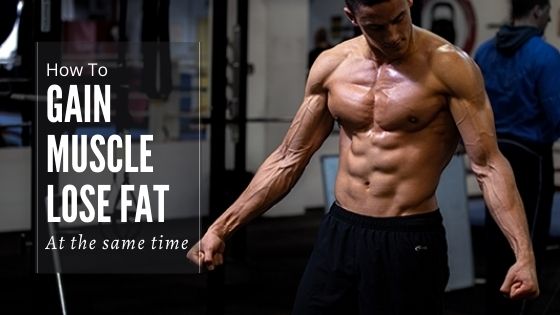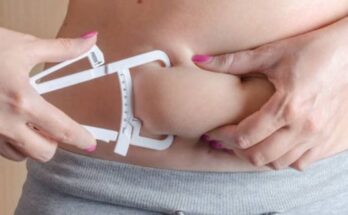As a gym trainer, the most common question people ask me is “how can I gain muscle and lose body fat at the same time?”. People often want to transform their physique in the best and quickest way possible but they don’t know how to do that.
If you also have such query then this science-based article will clear all your doubts. So lets get started.
Is it possible to Gain Muscle & Lose Fat at the same time?
Well, unlike the common bulking and cutting cycle, our body is smart enough to burn fat and build muscle simultaneously.
To gain weight and build muscle you have to eat in a caloric surplus (eat more calories than you burn). While to lose weight, you have to be in a caloric deficit (to eat fewer calories than you burn). This is a common notion that most people believe.
Due to this belief, many people think that it is not possible to gain muscle and lose body fat at the same time (also called body recomposition). However, this is not that simple. Our body is way smarter than we think.
In fact, there is enough evidence to prove that it is feasible to build muscle and lose fat simultaneously. If you follow a proper training and nutrition plan then you can definitely do that. However, for some people, it is more effective than others.
Who can experience Body Recomposition?
Body recomposition is different from the common “bulking and cutting” approach. It is a process in which you change your lean muscle mass and fat percentage. In other words, gaining muscle mass and losing body fat simultaneously.
However, unlike the traditional “bulking and cutting” approach, there is a catch in this process. It is not feasible for everyone. Body recomposition is more effective if you come in one of the following categories:
- Beginners. This means you have a training experience of several months only or you’re in your first year of training.
- For overweight individuals. People with a body fat percentage of above 25 or 30%.
- If you’re detrained. That means if you’re off training for a considerable period of time (some months)
- For beginner to intermediate lifters. Though the process is at a much slower rate.
For trained and advanced-level individuals, it is much less likely to happen. But if you are someone from the above four categories, then you must give it a try.
3 steps to Lose Fat & Build Muscle simultaneously
No matter to which category you belong to, there are some key points you have to follow to successfully attain body recomposition. Here’re the three steps of how you can gain muscle and lose body fat at the same time.
Step 1 – Go on a slight calorie deficit
A small caloric deficit is crucial to successfully build muscle and lose fat simultaneously. A higher caloric deficit (much more than 500 calories) is no doubt help you lose fat. But along with fat, you will lose your hard-gained muscles also.
Hence, set a slight caloric deficit of 5% to 20% of maintenance calories so that you are able to support your muscle gain while losing fat simultaneously.
For most people, this would be about 150-500 calories. If your body fat percentage is low then stick to the lower range. And vice versa for the people with high fat percentage.
In a 2011 study done on the trained athletes for a period of 9 weeks. “They were able to gain muscles while losing about 0.7% of their body weight per week“. This shows that even trained individuals can achieve body recomposition at a slower rate.
One thing you need to remember that the more trained you are the lesser should be the caloric deficit. Otherwise, you may lose some muscle mass too, forget gaining.
Also, keep in mind that your weight might remain the same or even increase during this process. This is because you are losing fat and gaining muscle simultaneously and muscle is about three times denser than fat.
It would be better if you forget about losing weight and think in terms of fat percentage.
Step 2 – Keep your protein intake high
Protein is the building block of muscle. Despite being in a caloric deficit, enough supply of protein is very crucial for preserving and building muscles.
But how much protein do you need?
According to a meta-analysis published in the Journal of Sports Medicine,
0.8-1.2 grams of protein per lb of body weight are optimal for building muscles while doing body recomposition.
Related: 13 High Protein Foods for Lean Muscle Gain.
Going beyond this range might not give you any extra benefit. As in the case of protein, more is not necessarily the better. However, going below this range can affect you negatively and you may lose your muscle mass.
In 2018, a study was done at Schoenfeld to see the effects of high versus low protein intake on body composition. They showed that “subjects on a high protein diet (~1g/lb of bodyweight) gained muscle while losing a kg of fat. Whereas, subjects on a low protein diet (~0.4g/lb of bodyweight) still lost fat but some of them also lost muscle or didn’t gain any muscle“.
Hence, body recomposition is more feasible with a high protein diet. However, there’s no one size fits for. So start with any number in that range and keep experimenting yourself to see how your body responds.
Step 3 – Optimize your training accordingly
As you know that nutrition and training go hand in hand. So next we are going to focus on how you should train to gain muscle and lose fat at the same time.
You can build muscles just by taking a protein-rich and healthy diet. Your muscles need a stimulus to grow which we provide through resistance training.
For complete beginners, it is comparatively easy to grow muscles, “newbie gains“. But as you gain experience, you need to take a smart approach to do progress in the gym.
The key factor to grow your muscles is – progressive overloading. Also, plan your workout to maximize muscle hypertrophy.
Progressive overloading means gradually and continually increasing the stress on your musculoskeletal system. It is essential to gain muscle mass, increasing muscular strength, and endurance. Whereas, muscle hypertrophy simply means increase in the size of your muscle cells.
Read more: How To Maximize Muscle Hypertrophy?
Here’re the other things you have to consider while designing your training routine for body recomposition.
- Training frequency: Train each and every muscle 2x/week.
- Volume: Train with enough volume. 10 to 20 sets per muscle group per week would be optimal.
- Rest & Recovery: Muscle growth happens during rest. So give your ample time to recover after the workout (about 2-3 days of rest for a muscle group)
- Rep Range: Do most of your sets in strength and hypertrophy rep range (5-12 reps/set).
- Cardio: Avoid doing cardio before weight training session. Cardio before weight training can interfere with your workout and degrade your performance.
No matter which training protocol – push/pull/leg, upper/lower, or split training you follow, you can inculcate the above things in any routine.
Gain Muscle Lose Fat At The Same Time – ACTION PLAN
Here’s an example action plan which sums up the whole article.
Nutrition
As far as nutrition is concerned, the first and foremost thing is to find the calories requirement. For this, take a slight calorie deficit of 5-20% or 150-500 calories. The second important step is to set up your macros (especially protein intake). For this, start your journey with ~1 gm protein per pound of bodyweight and then optimize as per the results.
- For instance, you are a young boy who weighs 160 pounds. Now on the basis of your activity level, find your maintenance calories or BMR online. Let’s say it come out to be 2550 calories.
- I’m assuming that you don’t have too much fat. Therefore putting a calorie deficit of 250 and your daily calorie requirement comes out to be 2300 calories.
- With 1g/lb of bodyweight, you start with 160 grams of protein daily.
- Take ~20-30% of fat and fill the rest of the calories with carbs.
By taking reference from this, you can easily design a nutrition plan for yourself.
Training
Make sure you are training each and every muscle with optimal frequency and enough volume. Train each muscle 2x/week with the proper mind-muscle connection. Do most of your sets in the hypertrophy rep range (6-12 reps/set) and incorporate the principle of progressive overloading smartly.
Remember that the human body is adaptive in nature and gets used to what you are giving it for a long time. So keep switching up your training routine about every 3 months. This helps in breaking the plateau.
Apart from this, make sure you are taking enough rest for the recovery of your muscles. Remember, rest is as important as training and nutrition.
The Takeaway
So, can you gain muscle and lose body fat at the same time? Definitely Yes. Though, body recomposition is not for everyone. Especially for intermediate to advanced lifters, there’s a very thin chance to gain muscle and lose fat simultaneously.
However, if you are a beginner, overweight, or detrained individual, then you should definitely give it a try. The results would be very fruitful if you follow each n every step with discipline and dedication.
Take daily notes of your diet, how much weight you are lifting at the gym, and your body measurements. If your weight remains almost the same but you are losing inches from your waist, getting stronger in the gym, looking better without clothes, then these are the indicators that you are gaining muscles while losing fat at the same time.




